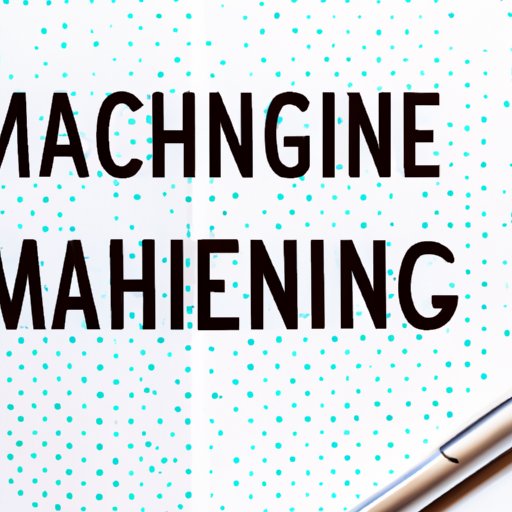
Introduction
Machine learning models are becoming increasingly important as technology advances. They are used to solve complex problems in various industries and provide valuable insights into the behavior of systems and people. Understanding these models and how to use them is critical for anyone interested in data analysis, problem-solving or decision-making.
A Beginner’s Guide to Understanding Machine Learning Models
Machine learning is a subset of artificial intelligence (AI) that uses algorithms to learn from and make predictions or decisions based on data. The goal is to develop an accurate model that can analyze new data and make predictions or decisions without human intervention.
There are three types of machine learning: supervised, unsupervised, and reinforcement learning.
Supervised learning relies on labeled data, where the model tries to find a relationship between input features and given output labels. On the other hand, unsupervised learning learns patterns in data without any predefined labels. Lastly, reinforcement learning learns from past experiences, understands the consequences of past decisions, and tries to maximize rewards while minimizing failures.
Machine learning models rely on an algorithm, which is a set of rules or logic that the model uses to learn from the data. The algorithm is trained on a dataset, and the model extracts useful insights and patterns from it. These insights can then be used for prediction or decision making.
Use cases for machine learning models include fraud detection, recommendation systems, predicting customer churn, and many more.
Using Machine Learning Models to Analyze Data
Machine learning models can analyze large quantities of data to extract insights and trends that humans might not easily discover. They help businesses and organizations get a competitive edge by improving their efficiency, customer satisfaction, and revenue generation.
Machine learning algorithms play an essential role in analyzing data. They are the math behind machine learning models. For instance, linear regression is an algorithm used in supervised learning that predicts continuous numerical values given an input. On the other hand, clustering algorithms are used in unsupervised learning to group similar data points.
Businesses can also use machine learning models to optimize their energy consumption, improve their inventory management, and predict demand for products or services.
The Future of Machine Learning Models
Machine learning models are continually evolving and becoming more sophisticated. The rise of big data is fueling the increasing demand for machine learning models, particularly in healthcare, finance and many other industries.
Machine learning models are becoming more applicable in fields such as image recognition, natural language processing, and even autonomous navigation. With the rise of the Internet of Things (IoT), machine learning models will be critical in processing and analyzing vast amounts of data generated by connected devices.
In healthcare, machine learning models are used to identify the risk of diseases and optimize patient treatment. They can also help to diagnose the disease from radiological images. In finance, machine learning models are used to detect fraud and predict stock prices. The applications of machine learning models are endless and vary from one industry to the next.
How to Choose the Right Machine Learning Model
Choosing the right machine learning model is critical when developing a predictive model. There are several factors to consider, such as the size of the dataset, the type of variables, and the accuracy required.
The choice of the algorithm also matters. For example, if the data is linear, then the best model to use would be linear regression. However, if the data is non-linear, then a more complex algorithm, such as a neural network, would be necessary to achieve the required level of accuracy.
It’s always essential to evaluate the performance of the model on new data before deploying it to the production environment. There are several performance metrics like classification accuracy, regression error, confusion matrix, and many more used to evaluate the performance of a model.
Common Mistakes to Avoid When Building Machine Learning Models
Building a machine learning model can be a challenging task, especially for beginners. There are several common mistakes that people make, such as overfitting the model to the training dataset, not normalizing the data, or picking the wrong algorithm to trained the data.
Overfitting is when the model becomes too complex, and it starts to fit the noise instead of the signal, leading to poor performance on new data. Normalizing the data helps to rescale the data to the same range, and this improves the performance of the model. Picking the wrong algorithm for the dataset might lead to a low accuracy model.
The best way to avoid these mistakes is to have a clear understanding of the data and the problem statement. It’s essential to know why you’re building the model, what question you’re trying to answer, and what data you need to answer that question accurately.
Conclusion
Machine learning models are critical in today’s world as they provide valuable insights from the overwhelming amount of data generated every day. Understanding these models helps in solving complex problems in various industries, ranging from healthcare to finance.
Choosing the right algorithm, understanding the data, and avoiding some common mistakes are necessary to develop an accurate model for making predictions or decisions. Machine learning models are continually evolving, and they will play a significant role in shaping the future of technology.
Apart from analyzing data, machine learning models can also be used in industries like finance, healthcare, and autonomous navigation, among others.




